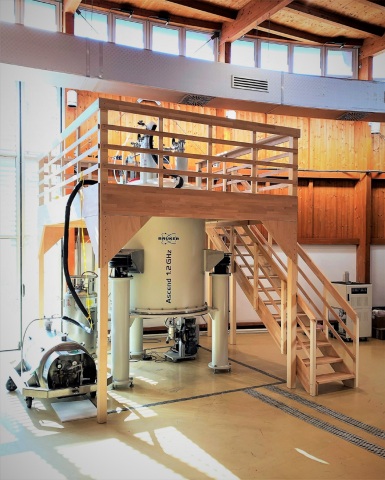First 1.2 GHz NMR System Delivered to CERM at the University of Florence, Italy
BALTIMORE--(BUSINESS WIRE)--
At the Experimental Nuclear Magnetic Resonance Conference 2020 (ENC), Bruker Corporation (Nasdaq: BRKR) announces the recent delivery of the world’s first Avance™ NEO1.2 GHz NMR system to the CERM at the University of Florence, Italy, and the first installation of an Avance NEO1.1 GHz system at St. Jude Children’s Research Hospital in Memphis, TN. Bruker has now successfully brought three 1.2 GHz magnets to field at its Swiss GHz-class magnet facility. Moreover, Bruker has received two additional 1.2 GHz customer orders in late 2019, with first orders from the United States (The Ohio State University) and Korea (KBSI).
This press release features multimedia. View the full release here: https://www.businesswire.com/news/home/20200309005165/en/

Bruker 1.2 GHz NMR Spectrometer at CERM at University of Florence, Italy (Photo: Business Wire)
Professors Lucia Banci and Claudio Luchinat at the CERM of University of Florence, stated: “We are very excited to have received the world’s first 1.2 GHz NMR spectrometer in our lab, a result of multiple years of research and development at Bruker in various fields ranging from superconducting material science, magnet design, probe technology and NMR spectrometer electronics. We are looking forward to putting the instrument to use in our research on the structures and function of proteins linked to neurodegenerative diseases, such as Alzheimer’s and Parkinson’s Diseases, as well as in cancer research.”
The new GHz-class NMR technology is now enabling novel research in functional structural biology of proteins and protein complexes. Research includes the structures, dynamics and function of important globular proteins, membrane proteins and protein complexes. Ultra-high field NMR is also unique in that it can study the properties and interactions of intrinsically disordered proteins (IDPs), which make up 30-50% of the human proteome. IDPs play a crucial functional rule in fundamental cell biology, and they are also implicated in many instances of disease biology.
Dr. Falko Busse, Bruker BioSpin's Group President, stated: “We have continued to make good progress with our novel GHz-class NMR magnet technology, and we now focus on the installation of the world’s first 1.2 GHz NMR spectrometer in Florence, and on ramping up the small series production of additional 1.2 GHz systems. We have so far brought three 1.2 GHz magnets to field multiple times at our Swiss factory, indicating the robustness of our design. I am deeply grateful to our customers for their trust throughout the entire development phase, and we draw tremendous satisfaction from enabling important research in functional structural biology and IDPs.”
Bruker's unique GHz-Class NMR magnets utilize a novel hybrid design with advanced high-temperature superconductor (HTS) in the inner sections and low-temperature superconductor (LTS) in the outer sections of the magnet. The Ascend™ 1.2 GHz is a stable, standard-bore (54 mm) magnet with homogeneity similar to Bruker's existing 1.0 GHz and 1.1 GHz magnets for high-resolution NMR. The 1.2 GHz spectrometers are available with different ultra-high field probes, including CryoProbes for solution-state NMR and fast-spinning MAS solid-state NMR probes. At ENC 2020, our scientific collaborators will present outstanding 1.2 GHz high-resolution NMR data acquired with a new 1.2 GHz 3 mm triple-inverse TCI CryoProbe®.
About Bruker Corporation (Nasdaq: BRKR)
Bruker is enabling scientists to make breakthrough discoveries and develop new applications that improve the quality of human life. Bruker’s high-performance scientific instruments and high-value analytical and diagnostic solutions enable scientists to explore life and materials at molecular, cellular and microscopic levels. In close cooperation with our customers, Bruker is enabling innovation, improved productivity and customer success in life science molecular research, in applied and pharma applications, in microscopy and nanoanalysis, and in industrial applications, as well as in cell biology, preclinical imaging, clinical phenomics and proteomics research and clinical microbiology. For more information, please visit: www.bruker.com.

View source version on businesswire.com:
https://www.businesswire.com/news/home/20200309005165/en/
Investor Contact:
Miroslava Minkova
Director, Investor Relations & Corporate Development
T: +1 (978) 663-3660 x1479
E: Investor.Relations@bruker.com
Media Contact:
Thorsten Thiel, Ph.D.
VP of Group Marketing
Bruker BioSpin
T: +49 (721) 5161–6500
E: thorsten.thiel@bruker.com
Source: Bruker Corporation